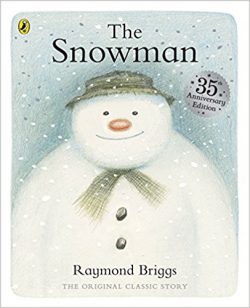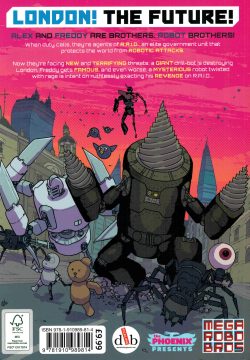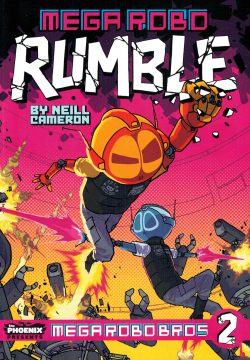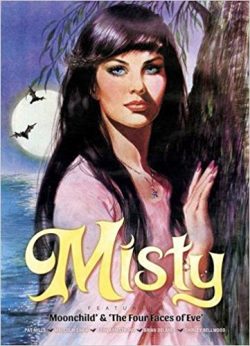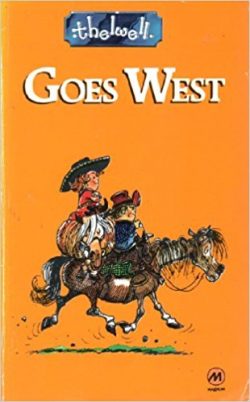
By Robert Duncan Low, Dudley D. Watkins, Ken H. Harrison & various (DC Thomson)
ISBN: 978-0-84535-614-9
Win’s Christmas Gift Recommendation: Evergreen Fun and an Ideal Last-Minute Gift… 10/10
We always get a wee bit Caledonian come Christmas in Win Wonderworld, so here’s another loving look at a matched pair of Scotland’s greatest exports whilst simultaneously revelling in the Good Old Days of comics…
If you’re too busy to read yet more of my lecturing, hectoring blather, please feel free to skip the review… just as long as you buy these books for yourself or someone in severe need of a good cheering up and infectious laugh…
Published eternally in perfect tandem, The Broons and Oor Wullie are two of the longest-running newspaper strips in British history, having appeared continuously in the Scottish Sunday Post since their dual debuts in the March 8th 1936 edition.
Both the boisterous boy and the gregariously engaging inner city clan were co-created by writer and Editor Robert Duncan Low (1895-1980) in conjunction with Dudley D. Watkins (1907-1969); DC Thomson’s greatest – and signature – artist.
Three years later the strips were collected in reprint editions as Seasonal Annuals; alternating stars and years right up to the present day and remaining best-sellers every single time.
The shape and structure of British kids cartoon reading owes a huge debt to Robert Duncan Low who was probably DC Thomson’s greatest creative find.
He started at the Scottish publishing monolith as a journalist, rising to the post of Managing Editor of Children’s Publications where – between 1921 and 1933 – he conceived and launched the company’s “Big Five†story-papers for boys. Those rip-roaring illustrated prose periodicals comprised Adventure, The Rover, The Wizard, The Skipper and The Hotspur.
In 1936 his next brilliant idea resulted in The Fun Section: an 8-page pull-out supplement for Scottish national newspaper The Sunday Post consisting primarily of comic strips. The illustrated accessory premiered on 8th March and from the very outset The Broons and Oor Wullie – both rendered by the incomparable Watkins – were its indisputable stars…
Low’s shrewdest move was to devise both strips as domestic comedies played out in the charismatic Scottish idiom and broad unforgettable vernacular. Ably supported by features such as Auchentogle by Chic Gordon, Allan Morley’s Nero and Zero, Nosey Parker and other strips, they laid the groundwork for the company’s next great leap.
That came in December 1937 when Low launched DC Thomson’s first weekly pictorial comic. The Dandy was followed by The Beano in 1938 (Happy Anniversary, guys!) and early-reading title The Magic Comic the year after that.
War-time paper shortages and rationing sadly curtailed this strip periodical revolution, and it was 1953 before the next wave of cartoon caper picture-papers. To supplement Beano and Dandy, the ball started rolling again with The Topper, closely followed by a host of new titles such as Beezer and Sparky.
Low’s greatest advantage was always his prolific illustrator Dudley Dexter Watkins, whose style, more than any other, shaped the look of DC Thompson’s comics output until the bombastic advent of Leo Baxendale shook things up in the mid-1950s.
Hailing from Manchester and Nottingham, Watkins was an artistic prodigy. He entered Glasgow College of Art in 1924 and before long was advised to get a job at Dundee-based DCT, where a 6-month trial illustrating boys’ stories led to comic strip specials and some original cartoon creations.
Percy Vere and His Trying Tricks and Wandering Willie, The Wily Explorer made him a dead cert for both lead strips in the proposed Fun Section and, without missing a beat, Watkins added The Dandy‘s Desperate Dan to his weekly workload in 1937, and The Beano‘s placidly and seditiously outrageous Lord Snooty seven months later.
Watkins soldiered on in unassailable magnificence for decades, drawing some of the most lavishly lifelike and winningly hilarious strips in illustration history. He died at his drawing board on August 20th 1969. For all those astonishingly productive years he had unflaggingly drawn a full captivating page each of Oor Wullie and The Broons every week.
His loss was a colossal blow to the company and DC Thomson’s top brass preferred to reprint old Watkins episodes in both the newspaper and the Annuals for seven long years before replacement artists were agreed upon. The Dandy reran his old Desperate Dan stories for twice that length of time.
An undeniable, rock-solid facet of Scots popular culture from the very start, the first Broons Annual (technically Bi-Annual) appeared in 1939, alternating with the first Oor Wullie book a year later (thanks to wartime paper restrictions, no annuals at all were published between 1943 and 1946) and for millions of readers no year can truly end without them.
Every kid who grew up reading comics has their own personal nostalgia-filled nirvana, and DC Thomson have always sagely left that choice to us whilst striving to keep all eras alive with carefully-tooled collectors’ albums like this substantial (225 x 300 mm) hardback Gift Book.
Bright and breezy, the compilation focuses on the characters’ relationship with food – particularly Scotland’s unique and evocative cuisine – through festive occasions, seasonal celebrations and in everyday contexts: especially in comedic situations as comfort or consolation or even hard-won prizes. It’s also jam-packed with some of the best-written and most impressively drawn strips ever conceived: superbly timeless examples of cartoon storytelling at its best…
Moreover, rather than a chronological arc tracing from particularly bleak and fraught beginnings in British history through years of growth, exploration and cultural change, we’re treated to a splendid pick-&-mix protocol: a surprise on every turn of a page with Low and Watkins ably succeeded by Tom Lavery, Peter Davidson, Robert Nixon, Ken H. Harrison, Iain Reid, Tom Morton, Dave Donaldson, Morris Heggie and more.
So What’s the Set Up?: the Brown family dwell together in a tenement flat at 10 Glebe Street in timelessly metafictional Scottish industrial everytown Auchentogle (sometimes known as Auchenshoogle and based on the working class Auchenshuggle district of Glasgow).
As such it’s an ideal setting in which to tell gags, relate events and fossilise the deepest and most reassuring cultural archetypes for sentimental Scots wherever in the world they might actually be residing. And naturally, such a region was the perfect sounding board to portray all the social, cultural and economic changes that came after the war…
The adamant, unswerving cornerstone of the family feature is long-suffering, ever-understanding culinary commander-in-chief Maw, who puts up with cantankerous, cheap, know-it-all Paw and their battalion of stay-at-home kids. These comprise hunky Joe, freakishly tall Hen (Henry), sturdy Daphne, gorgeous Maggie, brainy Horace, mischievous twins Eck and the unnamed “ither ane†plus a wee toddling lassie referred to only as “The Bairnâ€.
Not officially in residence yet always hanging around is sly, patriarchal buffoon Granpaw – a comedic gadfly who spends more time at Glebe Street than his own cottage and constantly tries to impart his decades of out-of-date, hard-earned experience to the kids… but do they listen?
Offering regular breaks from inner-city turmoil and a chance to simultaneously sentimentalise, spoof and memorialise more traditional times, the family frequently repair to their But ‘n’ Ben (a dilapidated rustic cottage in the Highlands) to fall foul of the weather, the countryside and all its denizens: fish, fowl, farm-grown, temporary and touristic…
As previously stated, Oor Wullie also launched on March 8th 1936 with his own collected Annual compilations subsequently and unfailingly appearing in the even years.
The premise is sublimely simply and eternally fresh: an overly-imaginative, impetuous scruff with a weakness for mischief, talent for finding trouble and no hope of ever avoiding parental or adult retribution when appropriate…
Wullie – AKA William MacCallum – is an archetypal good-hearted rascal with too much time on his hands who can usually be found sitting on an upturned bucket at the start and finish of his page-a-week exploits.
His regular supporting cast includes Ma and Pa, local beat-Bobby P.C. Murdoch, assorted teachers and other interfering adults who either lavish gifts or inflict opprobrium upon the little pest and his pals Fat Boab, Soapy Joe Soutar, Wee Eck and others. As a grudging sign of changing times, in later years he’s been caught in the company of sensible schoolgirls like Rosie and Elizabeth…
A compilation in monochrome – with some full-colour pages – Cooking Up Laughs! was released in 2016 as part of the admirable drive to keep early material available to fans: a lavishly sturdy hardback (still readily available through internet vendors) offering a tasty and tantalising selection curated with an emphasis on the eating habits of the stars.
Eating has always been a perennial and fundamental aspect of both strips (don’t get me started on the sociological value and importance of food in a communal or tribal setting: I’ve been to college twice and did all the reading they told me to!), and the topic has even generated a spin-off line of Maw Broon Cook Books…
Divided by colour cover or title-pages from previous Annuals, the endless escapades of the strip stars comprise the happily standard fare: kids outsmarting older folk to score sweets and prohibited provender; pompous male adults making galling goofs and gaffes when cooking; family frolics and festival events: rules of rationing and home-grown garden gifts; etiquette outrages: the penalties of gorging; stolen candies, Christmas revels, how to drink Tea and even some full-colour puzzle pages to digest…
Also on show are Scots-specific treats and techniques such as Clootie Dumpling disasters; the mysteries of Fruit; the makings of “a Pieceâ€; Fish Suppers and the miracle of Cheps; how to present Crofter’s Porridge; the marvel of Mince ‘n’ Tatties; better things to do with Neeps; dieting dos and don’ts and every manner of sweet and savoury sampling of succulence and sinfulness…
With snobs to deflate, bullies to crush, duels to fight, chips to scoff, games to win and rowdy animals (from cats to cows) to escape, the eternally affable humour and gently self-deprecating, inclusive frolics make these superbly crafted strips an endlessly entertaining, superbly nostalgic treat.
Packed with all-ages fun, rambunctious homespun hilarity and deliriously domestic warmth, these examples of comedic certainty and convivial celebration are a sure cure for post-modern glums… and you can’t really have a happy holiday without that, can you?
© D.C. Thomson & Co., Ltd. 2016.
